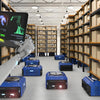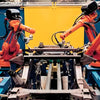TOF Cameras in Factories: Can They Enable Digital Twin Transformation?

TOF Technology Driving the Upgrade of Traditional Production Lines into Digital Twin Factories
With the rapid rise of Industry 4.0, traditional factories are under growing pressure to adopt smart manufacturing solutions. Conventional monitoring, manual inspection, and 2D vision systems are no longer sufficient to maintain production efficiency and quality. Digital Twin technology has emerged as a cornerstone for smart manufacturing, enabling virtual replication of physical production lines for real-time monitoring, simulation, and predictive decision-making. TOF (Time-of-Flight) cameras, with their high-precision 3D modeling capabilities, have become a critical enabler for creating accurate and dynamic digital twins.
What Is a Digital Twin?
A Digital Twin is a virtual model that represents a real-world object, system, or factory. By integrating live data from sensors, machines, and operators, it reflects the operational state and lifecycle of its physical counterpart. Essentially, it acts as a “digital mirror” of reality.
Key Features:
-
Real-Time Mapping: IoT devices, TOF cameras, and industrial sensors feed live operational data into the virtual twin.
-
Simulation & Prediction: Test different production scenarios in a virtual environment to forecast machine performance, maintenance needs, or workflow bottlenecks.
-
Optimization & Decision Support: Reduce costs and improve efficiency by simulating process changes without halting physical production.
-
Cross-Industry Applications: Digital twins are applied in aerospace, automotive, electronics manufacturing, energy, and smart city management.
For example, a digital twin of a CNC machine can monitor spindle speed, temperature, and vibration in real time, helping engineers predict wear, optimize maintenance schedules, and avoid costly downtime.
1. The Role of Digital Twins in Smart Manufacturing
Digital twins transform static 3D models and CAD designs into dynamic, interactive systems that evolve with production. They allow manufacturers to:
-
Monitor real-time production: Detect process deviations and machine faults immediately.
-
Optimize workflows: Plan assembly sequences, material handling, and maintenance proactively.
-
Reduce costs and errors: Test new production strategies virtually before implementing them physically.
In essence, digital twins close the loop between the physical and virtual worlds, enabling predictive manufacturing and smarter decision-making.
2. How TOF Enhances Digital Twin Accuracy
The accuracy of a digital twin depends heavily on real-time, precise data. Traditional 2D cameras and laser scanners often struggle with lighting conditions, object occlusions, or rapid movements. TOF cameras overcome these limitations by capturing high-precision 3D depth data at millisecond speeds.
Key Advantages of TOF for Digital Twins:
-
Real-Time 3D Modeling: TOF sensors generate dense point clouds of machinery, components, and production environments, forming the spatial foundation of digital twins.
-
Dynamic Updates: Continuously track machine states, part positions, and operator movements to maintain synchronization between physical and virtual systems.
-
Process Optimization: Detect misalignment, dimensional errors, or assembly deviations early, reducing scrap and improving throughput.
TOF essentially serves as the 'sensory layer' of the digital twin, bridging the physical production line with its virtual counterpart.
3. Application Cases
Automotive Manufacturing
In automotive assembly, thousands of components must fit together precisely. TOF-based digital twins enable:
-
Accurate Part Alignment: Real-time 3D coordinates guide robotic arms for precise installation.
-
Virtual Workflow Simulation: Test assembly sequences and detect collisions virtually.
-
Shortened R&D Cycles: Rapid validation of new vehicle models reduces the need for costly physical prototypes.
Precision Electronics
For semiconductor and PCB production, tolerances are extremely tight. TOF cameras integrated with digital twins provide:
-
Micrometer-Level 3D Modeling: Capture detailed chip and component geometries for high-precision assembly.
-
Dynamic Process Correction: Adjust welding or micro-assembly robots in real time.
-
Defect Detection and Traceability: Identify faulty components immediately and track root causes.
These applications demonstrate TOF digital twins’ ability to improve efficiency, quality, and operational flexibility across industries.
4. Integration Challenges and Solutions
Deploying TOF-driven digital twins at scale requires addressing several challenges:
-
Data Standardization: Devices from different vendors produce heterogeneous data. Unified standards are essential.
-
System Integration: Connecting TOF data to PLM, MES, and ERP systems requires robust interfaces.
-
Real-Time Processing: High-frequency 3D data demands edge computing, GPU acceleration, and cloud platforms.
-
Security: Data transmitted across industrial IoT networks must be protected against cyberattacks and tampering.
By overcoming these challenges, TOF can fully realize the potential of digital twins in smart factories.
5. Future Outlook
The synergy of TOF and digital twin technology will continue to transform manufacturing:
-
Full-Stack Smart Factories: Digital twins will cover design, production, quality control, and after-sales service.
-
Adaptive Factories: TOF-enabled real-time monitoring supports AI-driven self-adjusting production schedules.
-
Cross-Industry Expansion: Logistics, energy, and construction sectors can leverage TOF digital twins for real-time 3D monitoring and predictive maintenance.
As computing power and algorithms advance, TOF will become a core sensing technology for Industry 4.0, powering flexible, intelligent, and sustainable industrial ecosystems.
Conclusion
TOF technology is revolutionizing traditional production lines by providing accurate 3D data for digital twins. It enhances real-time monitoring, predictive analysis, and process optimization, driving efficiency, quality, and cost reduction. In the era of smart manufacturing, TOF-enabled digital twins are the cornerstone of next-generation factories, bridging the physical and virtual worlds to deliver intelligent, adaptive, and highly productive industrial environments.
IHaw Structured Light Camera P050 0.50M
After-sales Service: Our professional technical support team specializes in TOF camera technology and is always ready to assist you. If you encounter any issues during the usage of your product after purchase or have any questions about TOF technology, feel free to contact us at any time. We are committed to providing high-quality after-sales service to ensure a smooth and worry-free user experience, allowing you to feel confident and satisfied both with your purchase and during product use.








